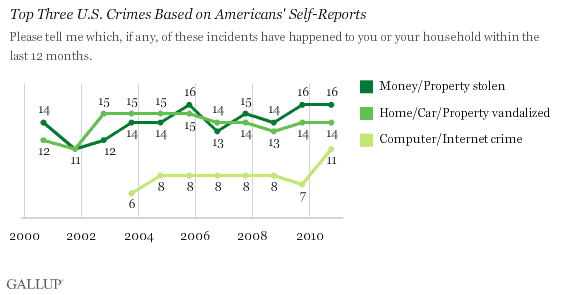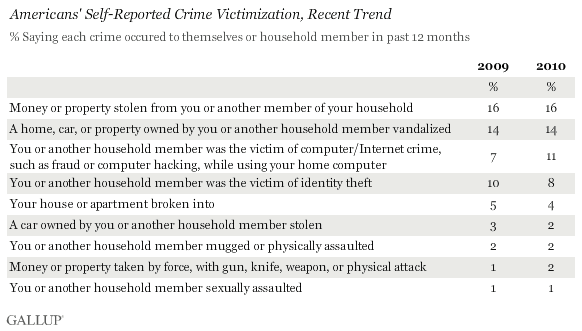PRINCETON, NJ -- With the WikiLeaks affair and broader hacking incidents related to it highlighting the potential for disruption of the Internet, Gallup's 2010 crime survey finds that computer-related crime is a growing problem for average Americans. Eleven percent of U.S. adults report that they or a household member was the victim of a computer or Internet crime on their home computer in the past year, up from the 6% to 8% levels found in the previous seven years.

Of the nine types of crime Gallup asked Americans about in the Oct. 7-10 survey, having money or property stolen received the highest mentions, at 16%, followed by having a home, car, or other property vandalized, at 14%. The trend for these has been fairly stable in recent years.
Computer/Internet crime is the only other type of crime that registers in the double digits this year. However, the next-most common -- identify theft, at 8% -- is closely related by virtue of much of it occurring through hacking and fraudulent Internet transactions. This is down slightly from the 10% who reported identity theft in 2009, the first year Gallup asked about this type of crime.
Fewer than 5% of Americans say that, over the past year, they or a household member was a victim in a home break-in, a car theft, a mugging or physical assault, a money or property theft by force, or a sexual assault.

One-Third of Households Are Victims
In the past year, a third of all U.S. households experienced at least one of the nine crimes Gallup measured, up slightly from previous years. When computer- or Internet-based crimes (including identity theft) are excluded, the figure is similar to prior levels, at 26%.
Overall, 4% of Americans say they or a family member experienced some sort of violent crime, including a physical assault, mugging, or sexual assault.

The increase since 2009 in American households reporting computer- or Internet-based crimes comes mainly from Americans under age 55. Eighteen- to 34-year-olds are almost twice as likely to report these crimes as they were a year ago, and 35- to 54-year-olds are also significantly more likely to do so. In contrast, the rate is virtually unchanged among those 55 and older.

Bottom Line
At 11%, computer-/Internet-based crime is edging closer in reported frequency to the most common traditional forms of crime involving nonviolent theft of personal property and vandalism. Further, the increase is an exception in the overall crime picture, in that Americans' victimization reports have been fairly steady over the past several years. Not only has the overall percentage of Americans experiencing any type of crime been fairly flat, but Americans' reports of specific crimes have been flat as well.
Whether the increase in computer-/Internet-based crime can be curbed by new methods to thwart it, or only expands along with Americans' use of the Internet, could have important implications for how positive the online experience is in the coming years, and how trusted it is by consumers.
Survey Methods
Results for this Gallup poll are based on telephone interviews conducted Oct. 7-10, 2010, with a random sample of 1,025 adults, aged 18 and older, living in the continental U.S., selected using random-digit-dial sampling.
For results based on the total sample of national adults, one can say with 95% confidence that the maximum margin of sampling error is ±4 percentage points.
Interviews are conducted with respondents on landline telephones (for respondents with a landline telephone) and cellular phones (for respondents who are cell phone-only). Each sample includes a minimum quota of 150 cell phone-only respondents and 850 landline respondents, with additional minimum quotas among landline respondents for gender within region. Landline respondents are chosen at random within each household on the basis of which member had the most recent birthday.
Samples are weighted by gender, age, race, education, region, and phone lines. Demographic weighting targets are based on the March 2009 Current Population Survey figures for the aged 18 and older non-institutionalized population living in continental U.S. telephone households. All reported margins of sampling error include the computed design effects for weighting and sample design.
In addition to sampling error, question wording and practical difficulties in conducting surveys can introduce error or bias into the findings of public opinion polls.
View methodology, full question results, and trend data.
For more details on Gallup's polling methodology, visit www.gallup.com.
